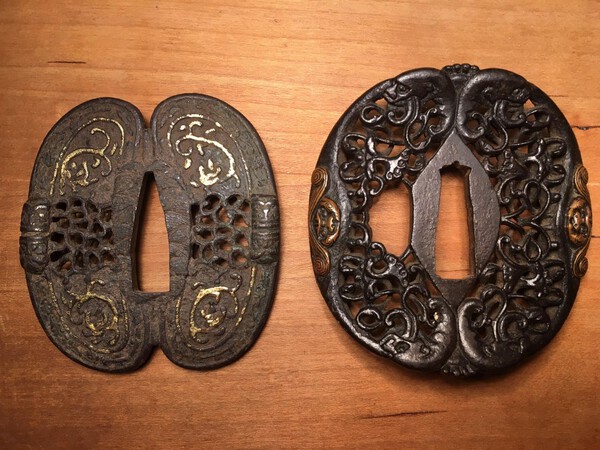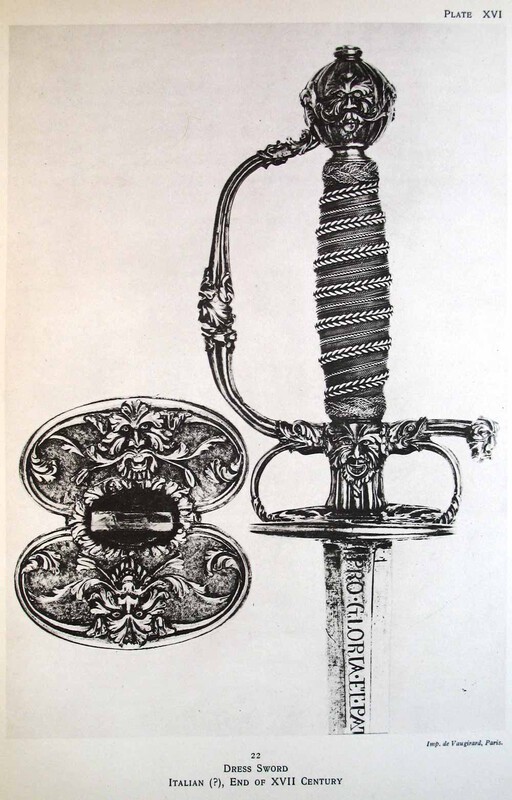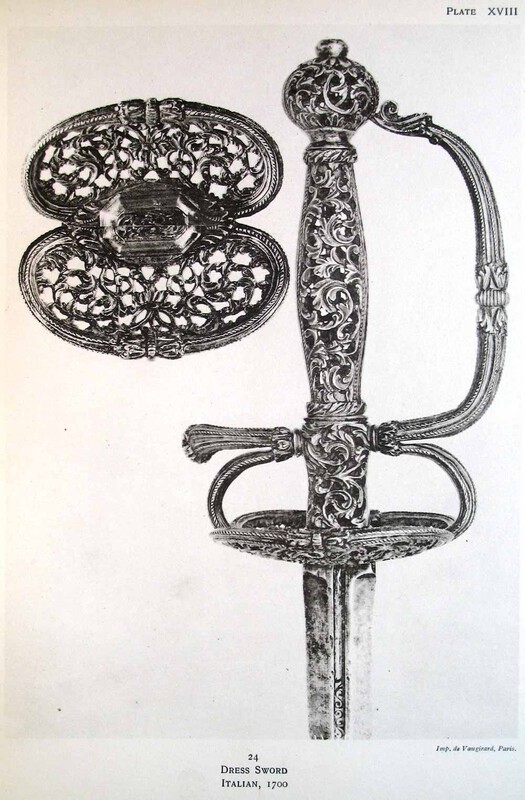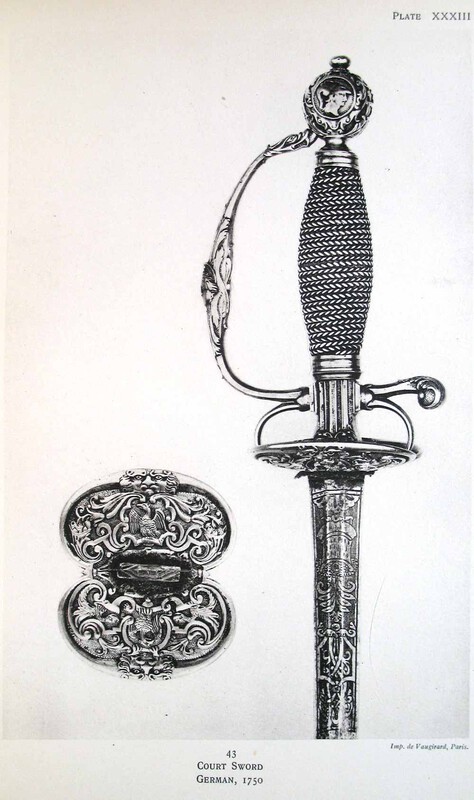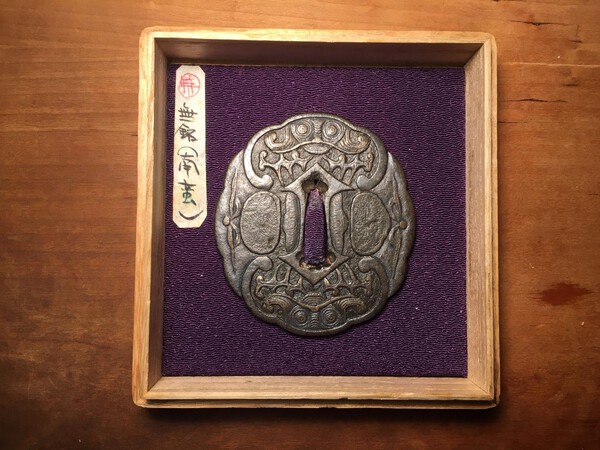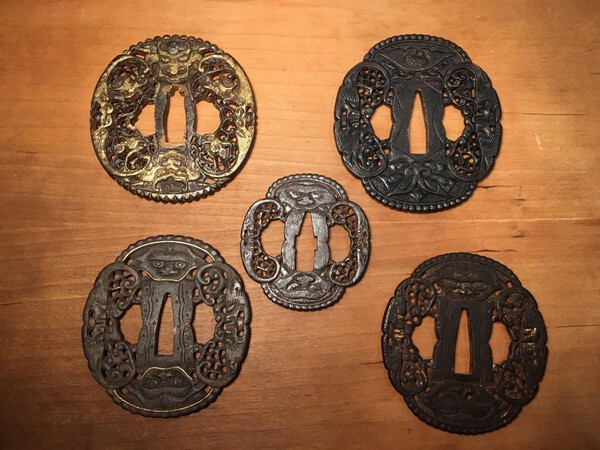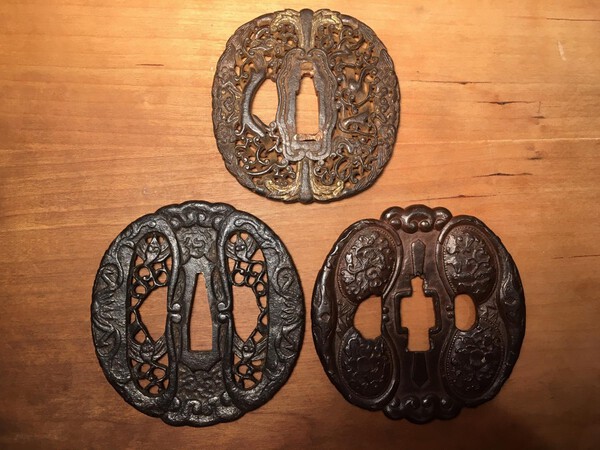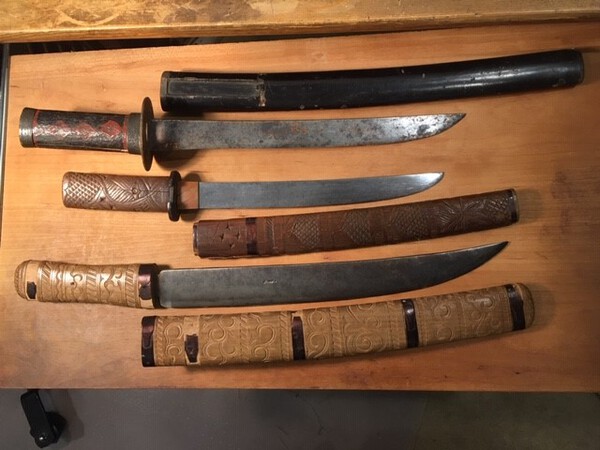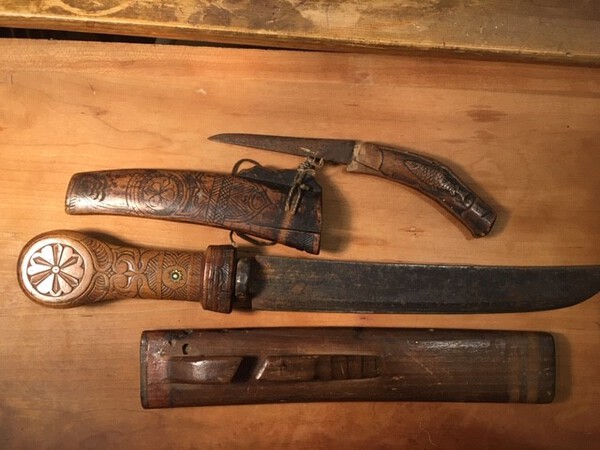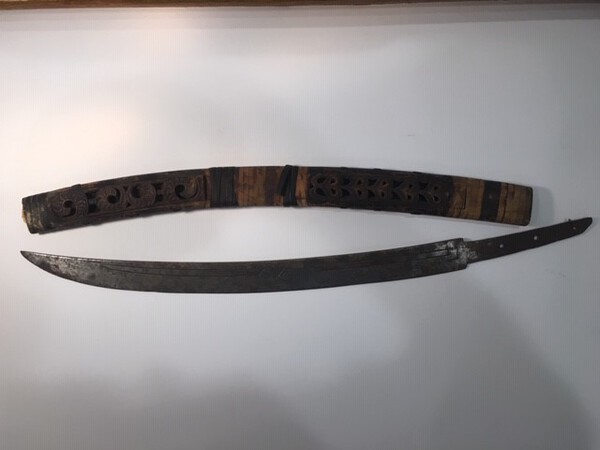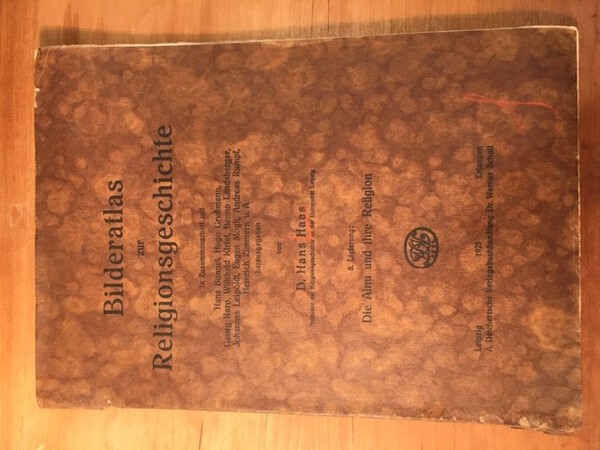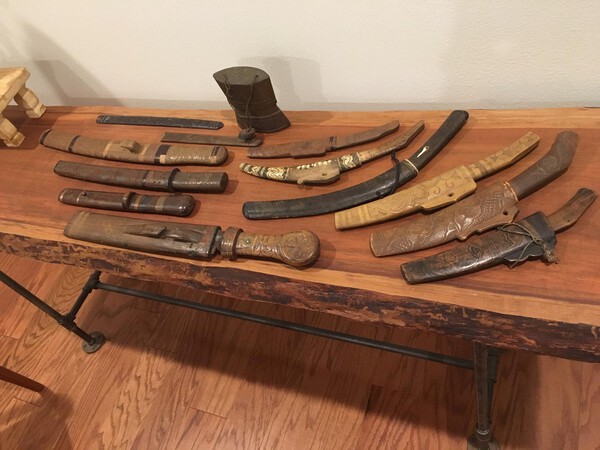
Peter Bleed
Gold Tier-
Posts
1,835 -
Joined
-
Last visited
-
Days Won
8
Content Type
Profiles
Forums
Events
Store
Downloads
Gallery
Everything posted by Peter Bleed
-
file:///C:/Users/peter/.... My friend Doug Scott just sent me this link - - - which I had never seen. The world sure is a complex place! P
-
I tried to find interesting Kutsuwa in the old days, but they were hard to discover. I appreciate your taste and your work! Peter
-
Okay. Now please look at these two "Namban" tsuba. To me they do not look like the work seen on European swords, but the over all designs strike me as similar to European fittings. Look at the overall outline, the placement of grotesque faces, and the vine-filled panels. They also have something like a cupped appearance. P
-
Thank you to those who have honored me by looking at this stuff. My basic goal is trying to present evidence that would show the "European" roots of these sword fitting designs. I am sure that most of these thing fittings were made in Japan but I think they were inspired/copied after European designs. I strongly suspect that most of these were not direct copies, but rather that they were copies of designs that had entered Japanese production. Now I am well aware that many people say that these things were made somewhere other than either Europe of Japan - China, Vietnam, or Sri Lanka are often cited. But I just don't see a lot of evidence linking these fittings to those areas. Here are some pictures of "European" swords with guards that look to me like the sort of things that could have inspired production of "Nanban" guards. P
-
Wrong-sprong! It turns out that lots of bilobed tsuba were rotated 90 degrees - as if folks in Japan liked the design but didn't quite get the "biloded" design. This is an NBTHK papered "Nanban tsuba". It has lobes at top and bottom, and instead of Oni or other ogres it has round eyed characters with a curly hair and big long mustachios. Peter
-
And Dale, about "Nanban" "Namban" . Its the same word, one written as it would be rendered in kana, the other as it is pronounced. Japanese tend to type it with an "N". P
-
Thank you all for interesting reactions. I'm gathering my own thoughts and reactions. But to keep the conversation going, what do you think of this? I'm pretty sure that this was "Made in Europe" and rather harshly modified in Japan. Right? Peter
-
Dear Friends, I am trying to use my imposed isolation to present graphic evidence that will convince the sword world that MANY of what used to be called Namban tsubas were Asian (and probably Japanese) copies of European Smallsword guards. Do these look "European" to you? Peter
-
Chris and Steve raise big issues that I am not sure I am qualified to address. It certainly is the case that what "we" might call "Ainu" refers to a wide range of folks. Starting in the Nara period there were people who didn't buy into the whole Kyoto court/Emperor thing. They went by various names etc etc. By the later Edo period the "Japanese" had spread up to Hokkaido (oh, and down to Okinawa, too). The folks up north were organized in a variety of ways outside the Japanese imperial system, but basically they survived without rice agriculture. Thru the Edo period there was active trade between "Japan" and those folks and there was at least one serious "battle" that involve matchlocks and I assume other Japanese weapons. Bottom line is that there probably never was anything like a single cultural group that were called "Ainu" just like there never was a community of "Indians." What seems to me to be the case is that cultural communities in Hokkaido developed distinctive costumes and regalia and it became a commodity much as had Native American materials. Edo period also used swords and various other objects to mark individuals and families as allies. Just as colonial leaders had done in America, Siberia, China, and India, such weapons were given to both empower and mark allies - who then were also of course, able to profit from such relationships. So, what probably were pretty good Japanese swords made it north. So did lots of low-end "Trade Goods." There were also lots of showy ornaments. By Meiji times, Japan seems to have been awash in "old swords" and lots of that stuff made its way north. And then, starting in Meiji times and continuing up to today, there has been active trade in souvenirs - omiyagi - that present "Ainu motifs." Thanks for listening. Peter
-
Monumenta Nipponica 80 years and counting - a monograph
Peter Bleed replied to Baka Gaijin's topic in Other Japanese Arts
I, too, have enjoyed paging thru Monumenta. The sword community has lots of expertise and information that deserves to be shared. We ought to encourage dissemination and Monumenta Nipponica could be a worthy outlet. Peter -
1886? Sword. European style similar to naval swords?
Peter Bleed replied to MacTheWhopper's topic in Military Swords of Japan
But wait a minute. You mean people other than the Japanese used to make swords? Peter Forgive me. I was making a bit of a joke, but we Japan Hands tend to forget to look widely... P -
There was some interest in Ainu blades so I'll post a couple images. There are three typical Ainu blades, belt knives, bush knives, and then real swords. Most blades in all three categories were recycled Japanese blades. Some few were repurposed "nippon-to" but most look like utilitarian cutlery. What makes then "Ainu" is the fittings that got once they were in Ainu hands.There were also some few blades that are called "Yezo-to" that seem to have been forged either by Ainu smiths or at least up in Hokkaido to Ainu standards. These are not edge tempered or mounted like Nippon-to and they're pretty rare. I have one. It is shown as Ainublade3 . These swords always seem to have had very fragile fittings. I include a picture of a book that some might find or interest. Peter
- 8 replies
-
- 14
-

-
Since any excuse will do, here is a snap of some Ainu stuff I had out recently. Nothing important, but, hey,... Peter
-
This has been an interesting thread and I have been waiting for someone from Japan to tell us what is going one. In fact, Jussi has done a good job and gotten us started. My surficial understanding is that the "mei" on this sword is a rendering of a person's name, - apparently the name is Tanaka Kunihiro. And i can kind of see that in the posted mei. I'll bet there is a name for this style of calligraphy but I sure don' know what it is. I suspect that it is derived from very early Chinese script. I did, indeed, try to find some markings like this in sources on Ainu material culture and swords. And "YES" there are similarities, but this mei does not "look Ainu" to me. This sword also looks basically different from other Ainu blades. Peter
-
These are terrific. Please tell us about them. Where did you discover them? Peter
-
And a GREAT thread. Very useful and very interesting. Thanx Peter
-
What Is This I Found In A Sword Bag?
Peter Bleed replied to ChuckJ's topic in Translation Assistance
I'm not sure what Piers is seeing to suggest that this is a copy. It looks like it has a red edge stamp. At least it is an old copy of a 1973 vintage registration for a sword in Chiba prefecture - suburban Tokyo. Peter -
New Guy -- Any advice on this Shin Gunto
Peter Bleed replied to BrentMc's topic in General Nihonto Related Discussion
Brent, I think you made the rigth decision - and that you are well started. Recently at the Atlanta Show I saw a number of swords nicer than this change hands at this level AND move up in you direction. I bet you can find some interesting things. Good luck Peter -
Signed tsuba curious about signature
Peter Bleed replied to waljamada's topic in Translation Assistance
Adam, Please forgive me. I was harsh to you and should have ignored your inquiry. I am really sorry I did not do that. Please also let me also try to salvage this discussion - and my standing in this community - by discussing the tsuba you asked us about. Your tsuba is a legitimate, late Edo period (+/- 1800) fitting. At that time, quite a few men in Japan were expected to wear a sword. Even impoverished men could - and may have had to - wear a short sword. In my opinion your tsuba was the sort of fitting that could be available to those men. As you know, your tsuba is signed with the name SOTEN. It also has clear characteristics of having been cast rather than carved. That is to say, it was something like a mass produced product rather than an individually crafted accessory. "Soten" describes a group of workshops that made and marketed a distinctive style of tsubas that were popular and appropriate to most situations. They were the tweed sport coat with Dockers of the era. Soten guards also came in a wide (!) range of qualities At the high end Soten guards are individually created - and worth a lot of money. At the low end, basic Soten forms seem to have been cast of iron. After casting, these guards would have been cleaned up by hand and then moved on. The cast iron blanks were made with flat facets so that they could be shipped on to Soten workshop for further work. Some "gold" nunome highlights could be added. But the real hall mark of the Soten guards were soft metal highlights - faces and figured - applied over the iron. These highlights could be knocked out by apprentices and then soldered on to the iron blanks. Look at your tsuba. See those two flat areas right in front of your thumb in the middle picture? I think that is were figures could have been added - but weren't. Please compare your guard to this one for example. https://www.liveauctioneers.com/en-gb/item/76217151_18c-Japanese-sword-tsuba-sages-in-pine-grove-by-soten There are also many discussions of Soten fittings elsewhere on NMB. Again, I am sorry that I responded to you as I did. I hope you will forgive me Peter -
Signed tsuba curious about signature
Peter Bleed replied to waljamada's topic in Translation Assistance
Adam, I urge you to look at this item I just found. https://nordicknives.com/products/namban-tsuba It is stylistically unlike the piece you asked about, but LOOK at it. Look at the smooth surfaces and edges. I think you will find similarities to you tsuba. Peter -
Signed tsuba curious about signature
Peter Bleed replied to waljamada's topic in Translation Assistance
Adam, Early this week we discussed you - or at least people like you - on this Forum. You asked for help, you got a reaction from a real expert, and then YOU argued with what you were told. I think you should thank Geraint for his response. After that I urge you to google "Tsuba". That will bring you to an array of tsubas and answers to the question you have asked. Look at the crisp edges on good tsuba. Look at how experts present guards. What is "up" and "down"? Check the color of nice old iron - is it grey or black? -
Indeed, NOBUTSURA and a corrected rendering of the kanji seem to clarify the situation. Thank you all. In addition to the oshigara Peter showed us, Shinshinto Taikan lists this smith as a student of Kurihara Nobuhide who worked in Osaka during the Bunkyu times. Peter
-
I agree with the "REAL" side of this discussion. And I agree that it is probably a a nice early Murata-to - which seem slowly to be finidng a legal place in the history of swords. The engraving on the back strap looks very interesting. Comparing it to a Sacred Treasure is interesting but I am not convinced. I wonder if it might be something like a city/town crest. And I suppose that it could be a family crest. This is a darn nice sword that deserves thorough research and restoration in Japan IMHO Peter
-
I discovered the Nihonto Message Board about 10 years ago and loved it because it was a community of serious folks who asked serious questions and offered usefully concrete information. Now I am locked up in Coronavirus Prison. And in that space, it looks to me like NMB is changing - and not for the better. We are getting an increasing number of emergency demands for translations of "grandpa's sword." It sure looks to me like most of those situations deal with late War gunto. And even so, those discussions are generally far better than the all too common requests to assess obvious Chinese reproduction non-com swords. OMG! Are those guys too lazy or too stupid to find entry level sites themselves? And then there are the empowered newbies who demand that all 4 sides or every box is clearly explained in terms they already know - even if it entails use of totally inappropriate vocabulary - - like "squiggles". Out of boredom, I have also explored a couple of sword related venues on Facebook. Many of those are simply not worth the time it takes to scan them. The stuff that is shown is not very good and the discussion is quick and not thoughtful. It contrasts with the thoughtful discussions that can - and do - occur here on NMB. Peter
-
Thank you Moriyama-san. I couldn't make the SHIGE. Otheriwise it struck me as a completely legit Gunto. Peter


